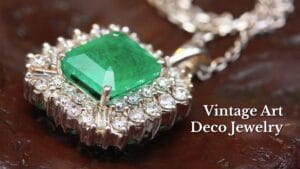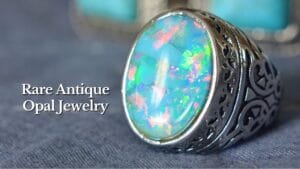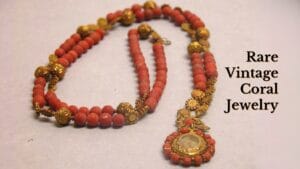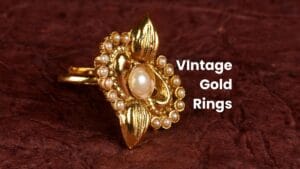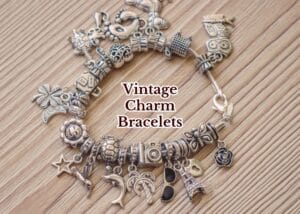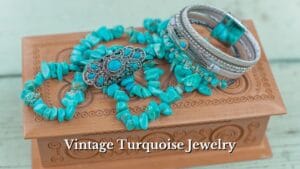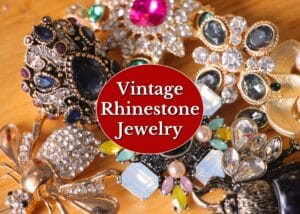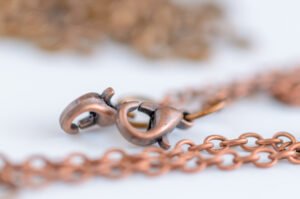When it comes to vintage jewelry, I’m sure you must have heard the word “Art Deco” countless times. While most people think of Deco jewelry as ‘cheap costume jewelry with random stones,’ it’s actually quite the opposite.
Don’t believe me? That’s okay! But you surely can’t overlook this bracelet that sold for a whopping $12,600! And this is just the beginning; some pieces have fetched $50,000!
So, before you throw or sell your antique Art Deco jewelry for just a few bucks, let’s check if it’s worth something more. With this guide, you’ll not only learn to spot authentic Art Deco jewelry but will also know its current worth using some rare examples!
The History of Art Deco Jewelry
Art Deco jewelry exploded onto the scene between 1920-1935, right after World War I, when society craved something fresh and modern. The 1925 Paris exhibition launched this revolutionary style, which combines machine-age precision with Egyptian archaeology and Asian art.
Major houses like Cartier and Van Cleef & Arpels created masterpieces using platinum, geometric designs, and innovative techniques. The style perfectly captured the optimism of the Jazz Age, making authentic pieces incredibly valuable today.
Key Signs to Identify Authentic Art Deco Jewelry
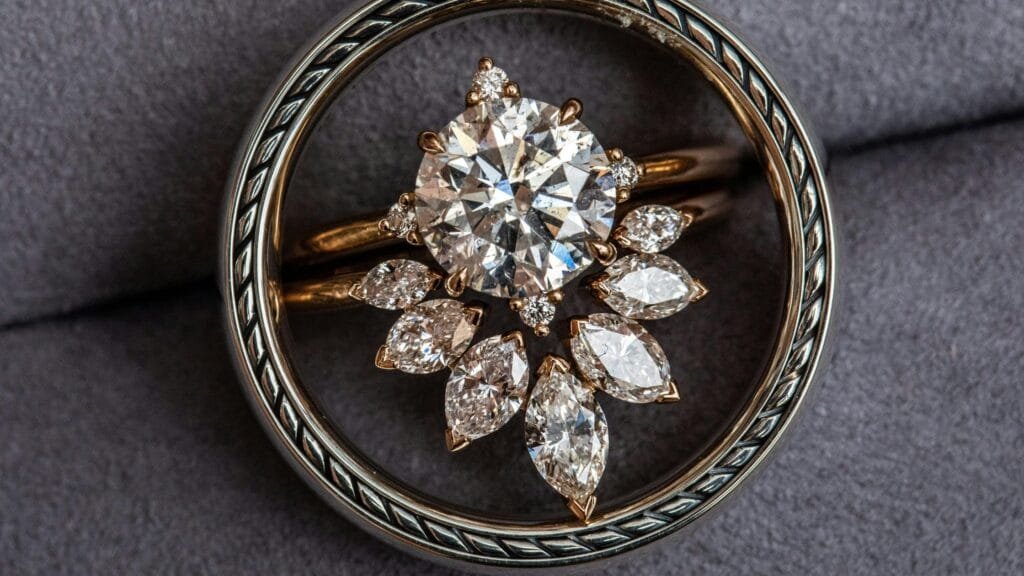
Spotting genuine Art Deco jewelry from other vintage styles, reproductions, or later copies needs keen knowledge of what features mark this specific era and what made it special. Here are the key signs to identify authentic Deco jewelry:
Design Elements
The first and most prominent indicator of genuine vintage Art Deco jewelry is its design. Real pieces literally scream the style by the way they are designed and crafted. Here’s a detailed breakdown of the key Art Deco design elements:
Sharp Lines and Bold Geometry
Real Art Deco jewelry looks “modern” even though it’s almost 100 years old. You can easily spot it by the clean, sharp lines everywhere—you’ll see triangles, rectangles, circles, and squares.
Some defining geometrical elements of retro Art Deco jewelry are:
- Stepped patterns that look like building facades
- Fan shapes radiating outward like sunbursts
- Angular intersections, where lines meet at precise points
- Architectural elements that remind you of the Chrysler Building
Symmetry and Linearity
Notable perfect symmetry and linearity are what really define the Art Deco era. You’ll always notice a strong sense of balance and order in the patterns. The designs are typically symmetrical and built on clean, sharp lines that feel almost architectural.
Machine Age Motifs
The machine age and industrial progress heavily influenced the Art Deco era. So technically, you will find the designs having a touch of industrial elements, such as machinery, skyscrapers, and transportation.
The key feature here is that all these motifs and elements are abstracted into perfect geometric forms and shapes.
Cultural Influences
With Art Deco jewelry, it’s not just the pretty symmetry and geometry. In 1922, archaeologists discovered King Tut’s tomb, and everyone went crazy for Egyptian designs. From pyramids to Cubist motifs, you’ll see this influence all over authentic Art Deco pieces.
You can spot a cultural Art Deco jewelry piece by the following design elements:
- Egyptian motifs like lotus flowers, scarabs, and pyramids
- Asian influences from increased cultural exchange
- Machine-age elements celebrating new technology
- Cubist inspirations with angular, abstract designs
Besides, Far Eastern influences also showed up in designs, especially inspired by Chinese and Japanese art. You’ll see dragons, pagodas, and traditional patterns, but again, all with a sense of geometric symmetry!
Key Materials
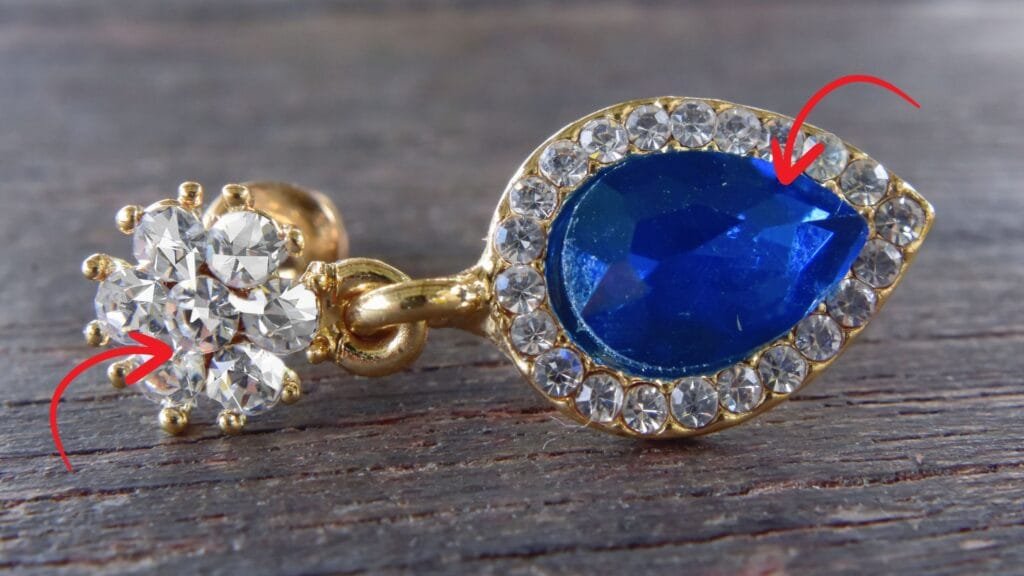
The materials are just as important as the designs to identify a real Deco jewelry piece. While it may not really drill down to the exact manufacturing era of a piece, certain materials do act like key indicators:
- Platinum and White Gold: These two precious materials literally ruled the high-end Art Deco jewelry production. Platinum’s white sheen fit the era’s color preferences perfectly. White gold was a more affordable and quite a popular alternative to yellow gold in this era.
- Enamel and Lacquer: These were a popular option to create those bold color fields and dramatic contrasts in Art Deco pieces, especially brooches and cameos. Vibrant enamel and sleek black lacquer mean an Art Deco piece.
- Bakelite and Celluloid: This era also saw the rise of early plastics, such as Bakelite and celluloid, in jewelry design. The primary use of these materials was in more accessible “costume” pieces, particularly to mimic expensive materials like jet, amber, and ivory.
- Chrome: Chrome plating in costume jewelry is another sign of its relevance to the Art Deco period. It was an effective way to achieve the desirable white metallic look of platinum without the cost.
My Tip: Authentic Art Deco white gold has a grayish tone, not the yellowish tint you see in modern pieces. If your “vintage” white gold looks yellow, it’s likely a modern reproduction using different alloys.
Notable Colors & Combinations
The Art Deco jewelry color palette is quite distinctive, ranging from bold and dramatic contrasts to soft, light shades. Hence, it is a key identifier of Art Deco pieces in itself.
- Bold Black and White Combinations: The Art Deco era was a fan of black & white combinations. You’ll see a lot of it in jewelry, as black onyx or enamel paired with diamonds, rock crystal (clear quartz) for the white elements, and black lacquer for settings.
- Vibrant Jewel Tones: Bold jewel tones are another defining feature of Art Deco style jewelry. Designers loved to add a pop of color to the settings using bold and colorful elements, such as deep blue sapphires (against platinum), emerald, and Ruby red.
- Subtle Accents: Art Deco pieces also display subtle contrasts! You’ll often see softer colors like coral, jade, and lapis lazuli that add striking contrasts to the dominant bold tones and black-and-white combinations.
- Egyptian Color Influence: Many Art Deco color combinations took inspiration from Egyptian artifacts, such as deep blues and golds, or turquoise paired with carnelian.
Popular Stones & Cuts
Knowing the key gemstones used in pieces and their distinctive cuts is crucial to spotting Art Deco jewelry. Below is a quick breakdown of the same:
Notable Stones
The Art Deco era is kind of known for its use of precious stones and newer materials in a way they were never used for jewelry.
- Diamonds: Diamonds were central to Art Deco design. Almost all high-end pieces typically feature Diamond work.
- Precious Stones: After diamonds, Art Deco designers were obsessed with sapphires, emeralds, and rubies, all in those new geometric cuts.
- Semi-precious Materials: Lapis lazuli, coral, jade, agate, and turquoise were commonly used for their vibrance and color play.
- Synthetic Stones: Some later Art Deco pieces may feature early lab-created stones that were revolutionary at the time.
- Cultured Pearls: You may also find cultured pearls! These are a kind of real pearl grown by the mollusk, but with human assistance (humans insert an object into the mollusk).
Common Stone Cuts
I know you might be thinking, How does just the stones help in identification? Well, it’s the cuts that speak of the era:
Diamond Cuts:
- Old European Cut: It’s a round cut with a smaller table and a higher crown. You’ll also see a larger culet than modern brilliant cuts. The stone’s unique chunky sparkle speaks for itself.
- Asscher Cut: This is a square step-cut that became super popular in the Art Deco period.
- Emerald Cut: This means rectangular step-cutting to bring out and enhance the stone’s clarity and color.
- Baguette and Trillion Cuts: These linear and triangular cuts were often used as accent stones to create geometric patterns.
- Antique Cushion Cut: Rounded squares with large, chunky facets.
Hallmarks, Marks, & More
Marks can give you invaluable information about the origin and authenticity of any Art Deco piece. From purity marks to renowned jeweler marks, here’s all you need to look for:
Metal Purity Marks
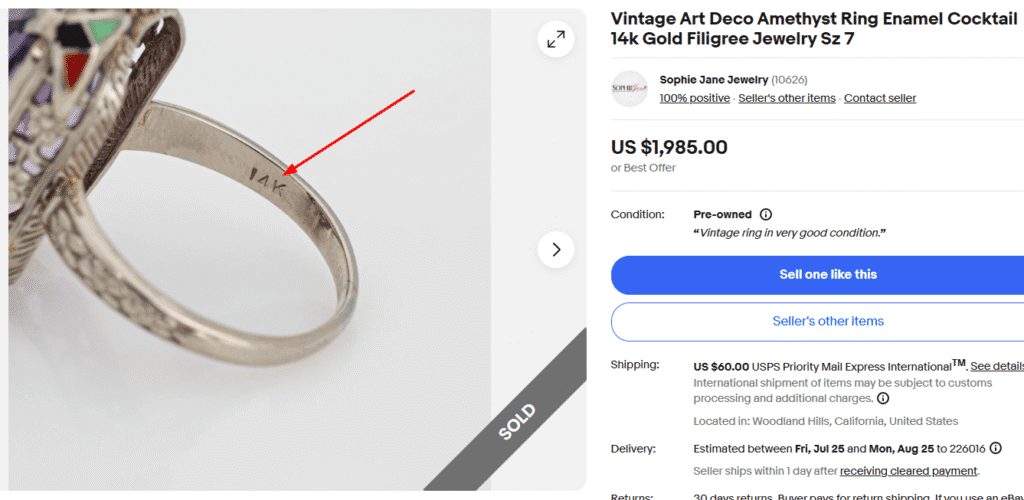
Hallmarks are like a vintage jewelry piece’s ID card. They tell you what it’s made of and often where it came from.
Generally, these marks are found on precious metals, like gold, Sterling, and Platinum. And these also differ based on the origin. For example, American marks are pretty straightforward:
- 10K, 14K, 18K for gold
- Sterling or 925 for silver
- PLAT or PT for platinum
On the other hand, European marks get more complex due to their symbolism:
- Eagle’s head: French mark for 18k gold (used since 1838)
- Dog’s head: French platinum mark (since 1912)
- Boar’s head or crab: French silver marks
In short, if you see those simple karat, Sterling, & PT marks, you’re looking at an American Art Deco jewelry piece. Those symbolic marks mean it’s a European beauty!
Maker’s Marks & Signatures
After hallmarks, there are maker’s marks! These will tell you who made the jewelry piece you’re looking at! Why is it important? Well, finding an authentic Art Deco piece from a famous house is like hitting the lottery!
Most renowned brands mark their pieces with their unique signatures and logos. Here are some popular names that ruled the Art Deco jewelry scene with their marks:
- Cartier: The king of Art Deco collectibility, features “Cartier” in block letters, often with “Paris” underneath. French pieces show eagle’s head hallmark and numbered pieces (like “Paris 33025”). Some pieces marked “Cartier London” or “Cartier New York”
- Van Cleef & Arpels: Van Cleef marks its pieces with “Van Cleef & Arpels” or “VCA” in script and often includes “Paris” and a serial number. French hallmarks are also present, with some pieces showing “V.C.A” in small letters. Look for the distinctive lozenge-shaped maker’s mark.
- Tiffany & Co.: Features “Tiffany & Co.” in distinctive font, with earlier pieces showing “Tiffany & Co. New York.” Most Sterling pieces have “925” or “Sterling.” You may also find the copyright symbol (©) on some pieces.
- Boucheron: Most pieces have “Boucheron” marked in elegant script, often including “Paris.” 18k gold pieces have French eagle’s head marks. Earlier pieces may also show “Boucheron Paris” in a rectangular cartouche.
- Lalique: Lalique marked its pieces from 1945 with “R. Lalique” in block letters, while post-1945 pieces have “Lalique” only, etched or molded into glass elements! Some pieces show “Lalique France,” and some early pieces may have an “R.L.” monogram.
- Marcus & Co.: You can find “Marcus & Co.” in elegant script, often including “New York.” Some pieces show just “Marcus” in a rectangular cartouche with American hallmarks
Patent Numbers & Dating Letters
Although very rare, you may sometimes see patent numbers marked on clasps or findings. These number markings are extremely useful in dating and authenticating a jewelry item – you can simply research the patent number to help date your piece.
Also, most British Art Deco pieces made before 1999 had to include date letters—a specific letter to denote the year it was registered. This makes dating super precise if you know the code.
Signs of Reproductions & Fakes
With Art Deco jewelry being so popular, there is a high chance you may come across fakes and reproductions. Here’s what to look for to spot a fake easily:
- Modern Brilliant Cut Diamonds: If you see today’s standard brilliant-cut diamonds in what’s supposed to be an Art Deco piece, it’s either a reproduction or the stones have been replaced.
- Modern Construction Techniques: Look for laser-soldered joints or those perfectly uniform, machine-made settings. Authentic pieces have subtle irregularities that prove they were handmade.
- Incorrect Materials: Rhodium plating over yellow gold to fake platinum wasn’t something they did back in the Art Deco era, so if you see that, be suspicious. Use of modern alloys that weren’t available in the 1920s is another key sign of fakes.
- “Signed” Pieces with Suspicious Marks need close inspection. Be wary of signatures that look crudely stamped, misspelled, or just don’t match known examples from that maker. Forgers often get the details wrong.
- Light Weight: If a piece feels light despite the claim of precious materials and natural stones, it’s a big red flag!
- Asymmetrical Patterns: Real Art Deco was obsessed with symmetry. Anything that feels off indicates a reproduction.
- Metalwork Signs: Modern wax-molded metal filigree work lacks the sharp precision that real Art Deco pieces showed. Plus, you will find modern claw settings instead of period millegrain work (beaded detail on the edge).
What Makes Retro Art Deco Jewelry Valuable?
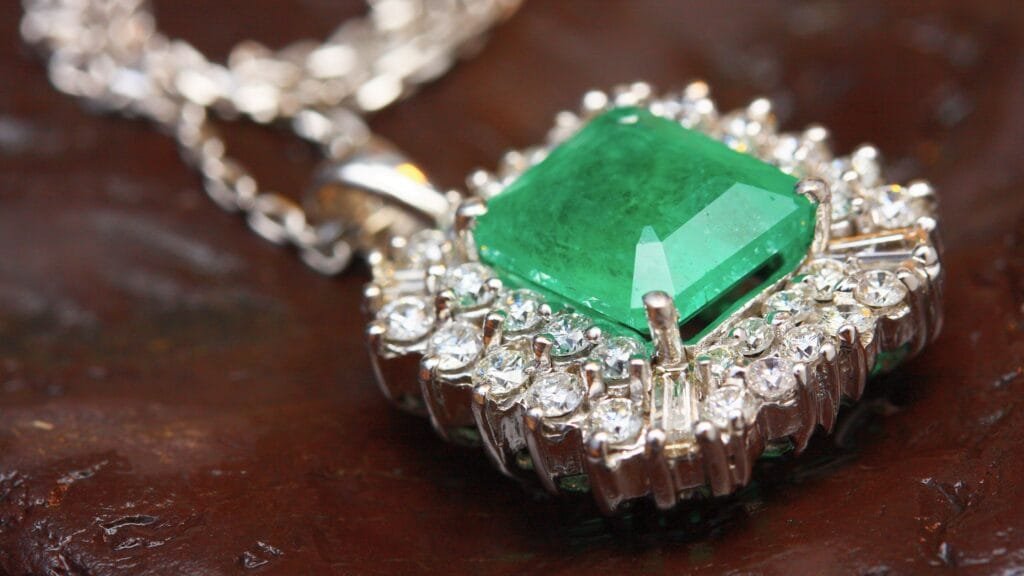
Now that you can spot authentic Art Deco pieces, let’s talk about what makes them worth serious money. In general, vintage Art Deco jewelry pieces can range from $100 to $100,000, no kidding!
And there are several factors that cause this HUGE range, from materials to much more!
Condition & Preservation
The first thing any serious collector looks at (and you should also) is the condition of a jewelry piece – the better the condition, the higher the value!
When it comes to assessing the condition, here are the things that matter the most:
- Structural Soundness: No cracks, breaks, or loose stones
- Original Components: All the pieces (stones, etc) should be there and authentic
- Working Mechanisms: Clasps, pins, and moving parts should function properly
- Surface Quality: Some wear is expected, but major damage kills value
- Enamel and Lacquer Condition: Chipping, cracking, or discoloration can reduce the worth
Restoration vs. Original?
While restoration is a red flag in the case of most antiques, professional restoration of jewelry can increase value if it’s done right; amateur repairs destroy it. So, always try to know what work has been done on your Art Deco piece.
Legitimate restoration that comes with records of what was done and by whom is not a big concern at all.
Material Quality & Combinations
The materials, including the base materials and stones, and how they’re combined, seriously affect the value of an Art Deco piece.
- Materials: Generally, platinum pieces command the highest prices. For white gold, 18k pieces are more preferred over and valuable than 14k pieces. Gold-platinum combinations get extra worth for period-correct mixing. Authentic quality silver can also be valuable with exceptional designs.
- Stones: Art Deco jewelry used both natural and early synthetic stones. Between these, pieces with natural gemstones are worth more than synthetic ones, even though synthetics were commonly used. Also, bigger, cleaner stones mean higher value.
- Cuts: Old European, Asscher, and calibré cuts will add more value. Examples with modern cuts are neither authentic nor valuable.
- Design Innovations: Retro Art Deco pieces with technical innovations are highly collectible. The examples include Van Cleef & Arpels’ “invisible setting,” Calibré cutting, mystery settings (floating stones), and transformable designs – pretty valuable!
Rarity & Uniqueness
Not all Art Deco is created equal; some pieces stand out for their unique elements and fetch higher values. Here’s what makes a jewelry piece rare:
- Design Rarity: Piece that stands out from common Art Deco designs are considered rare and fetch higher prices. Think unusual geometric patterns, size extremes (exceptionally large statement pieces), and convertible design.
- Material Rarity: Certain materials were used less frequently in Art Deco, making them more collectible. For instance, exceptional gemstones, rare stone combinations, early synthetics, and super exotic materials, like carved hardstones and enamel work.
- Production Rarity: Certain Art Deco pieces are quite rare due to their limited availability. Examples include special commissions (made for specific clients), limited production, experimental designs, and regional variations!
- Brand Popularity: Pieces made by renowned makers, like Cartier and Van Cleef, generally bring higher premiums than smaller makers or unmarked pieces.
15 Rare Art Deco Pieces That Sold for Serious Money
Now, let’s take a look at some rare antique Art Deco jewelry examples that are selling (and have sold) for eye-popping prices!
1. Art Deco Diamond Platinum Ring

- Brand: Unbranded
- Materials: Diamond, Platinum
This magnificent platinum Art Deco engagement ring features the clean lines and geometric patterns that defined the Art Deco movement. You can ensure it belongs to this era by the perfect symmetry of the deeply cut diamond and its frame.
Besides, this particular ring has the EGL (European Gemological Laboratory) certification, which further adds to the credibility and value – no wonder this clean and simple diamond ring sold for over $3,500!
2. Antique French Platinum 18 Carat Diamond Bracelet
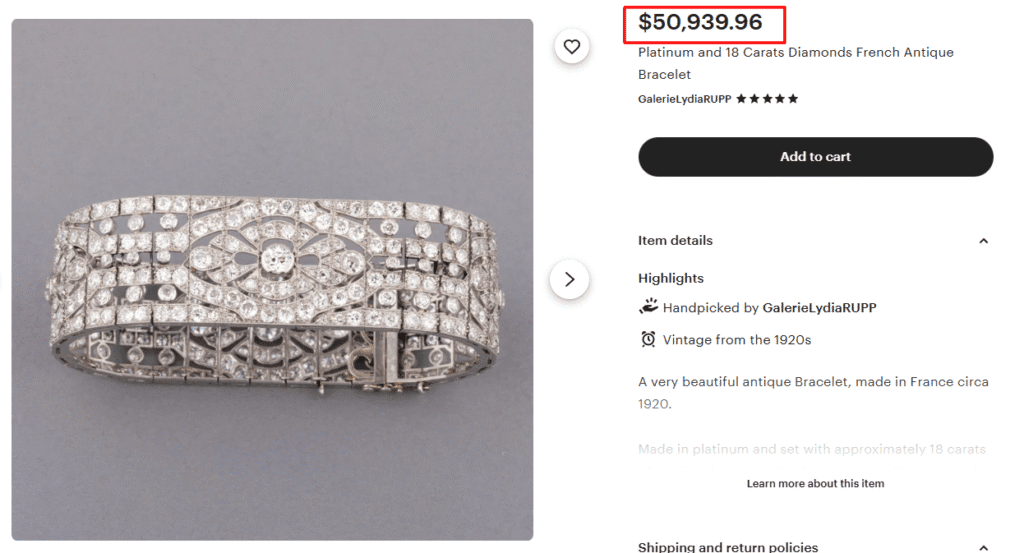
This vintage Art bracelet is selling for a mind-boggling price of almost $51,000! The reason? It has about 18 carats of diamonds set in platinum. The perfectly geometric and symmetric arrangement of these diamonds is what makes it a true Deco piece.
Finding such valuable antique jewelry pieces from the 1920s with all diamonds intact and in good condition is extremely rare today, justifying the stunning value.
3. Gubelin Ceylon Cabochon Sapphire Diamond Platinum Ring
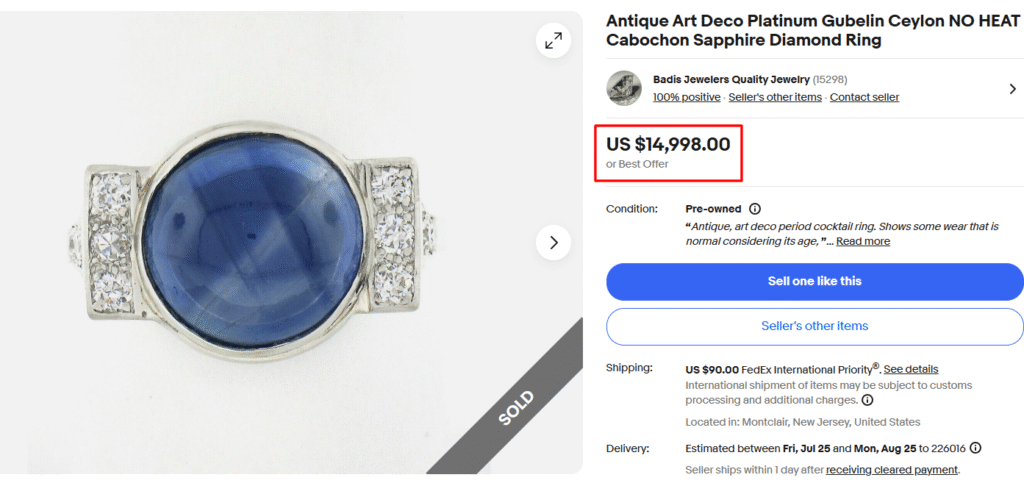
- Brand: Unbranded (Graded by Gubelin)
- Materials: Platinum, Diamond, Sapphire
Sapphire, diamond, and platinum make one of the most luxurious combinations in Art Deco pieces – and this vintage ring has it all! You’ll see a platinum body featuring a Gubelin-certified Ceylon sapphire with no heat treatment!
What’s so special about this? Well, 90% of sapphires you’ll find are heat-treated. So, a natural stone is incredibly rare, which is why this platinum diamond ring touched the steep price of almost $15,000!
4. Art Deco Old European Cut Diamond Platinum Ring
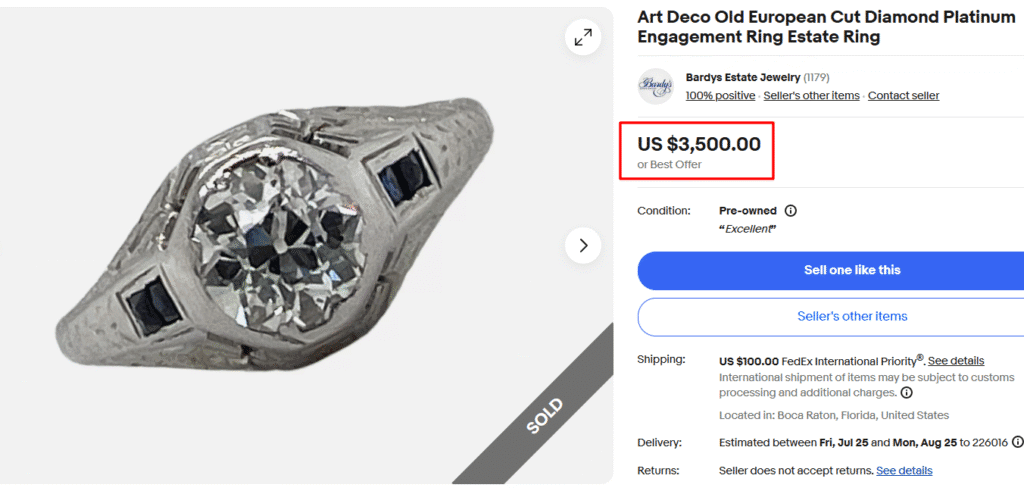
- Brand: Unbranded
- Materials: Old European Cut Diamond, Platinum
A regular vintage engagement ring becomes a rare vintage Art Deco beauty if it features the old European cut diamond set in platinum! The high crown and deep pavilion of the diamond is how you can authenticate this Deco piece – modern pieces have claws!
This ring seems to mark what we can call the era’s shift toward more geometric, architectural designs. In excellent condition, you can expect these rings to fetch $1,000-$5,000 or more!
5. French Boucheron Paris 18k Gold Sapphire Pendant
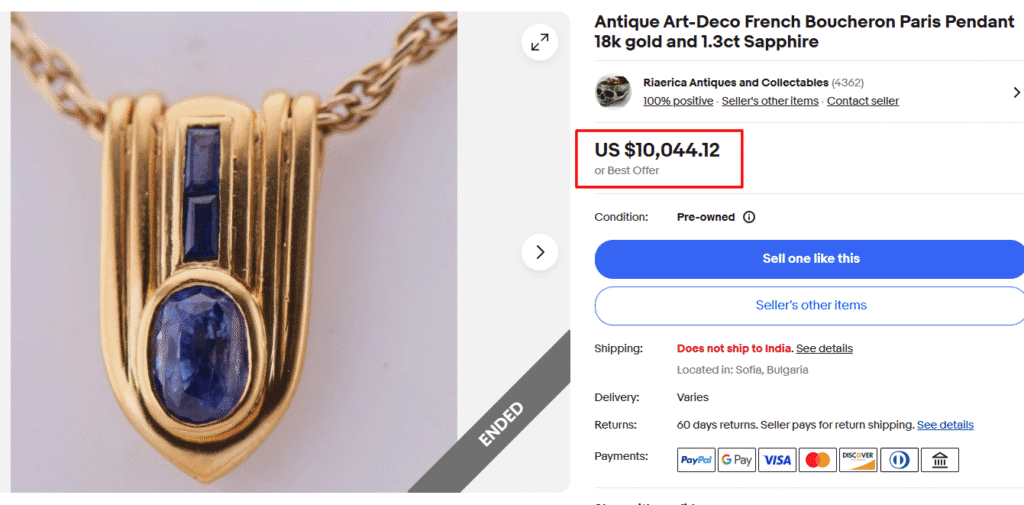
- Brand: Boucheron
- Materials: 18K Yellow Gold, Sapphire
This is a sleek 18K yellow gold pendant by Boucheron that screams Art Deco on top of the lungs! Coming from one of France’s most prestigious houses and dating back to the 1920s-30s Art Deco era, this piece has everything to be sold for a whopping $10,000+!
For instance, the 18k gold setting shows classic geometric lines with that gorgeous 1.3-carat sapphire that Art Deco is famous for. This piece is a true Boucheron, as the company was known for mixing unexpected materials – yellow gold with sapphire is not common!
6. Cartier’s Art-Deco French 18k White Gold Diamond Brooch
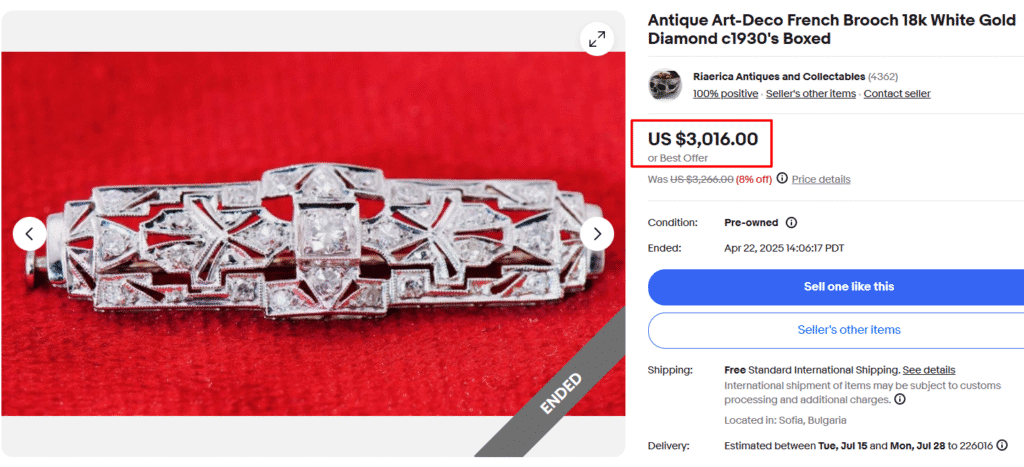
- Brand: Unbranded
- Materials: Diamond, 18K White Gold
Now, this brooch is a true reflection of the 1930s French Art Deco jewelry craftsmanship! It features elegant geometric diamond patterns set in 18k white gold – the defining feature of the era.
The intricate stonework and high-quality white gold make these vintage brooches highly valuable today, as justified by the $3,000 price tag for this luxurious piece!
7. Natural Deep Blue Aquamarine Diamond Platinum Ring
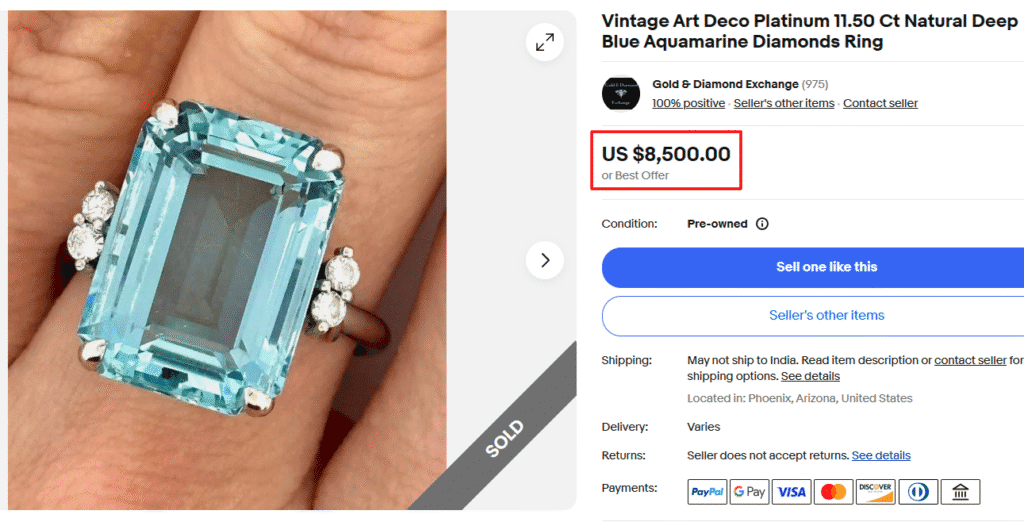
- Brand: Unbranded
- Materials: Deep Blue Aquamarine, Diamond, Platinum
This super luxurious vintage Art Deco ring flaunts a massive 11.50-carat natural deep blue aquamarine, basically an ocean captured in stone! Set in platinum with diamond accents, this ring is a true example of the Art Deco era’s obsession with colored gemstones.
The precisely geometric cut on stone and the symmetric alignment of diamonds are the key identification signs of this Deco ring – such precision isn’t common! With a huge gemstone and precious metal, this piece justifies the price of $8,500 – could go beyond $10,000!
8. Art Deco Diamonds & Rubies White Gold Earrings
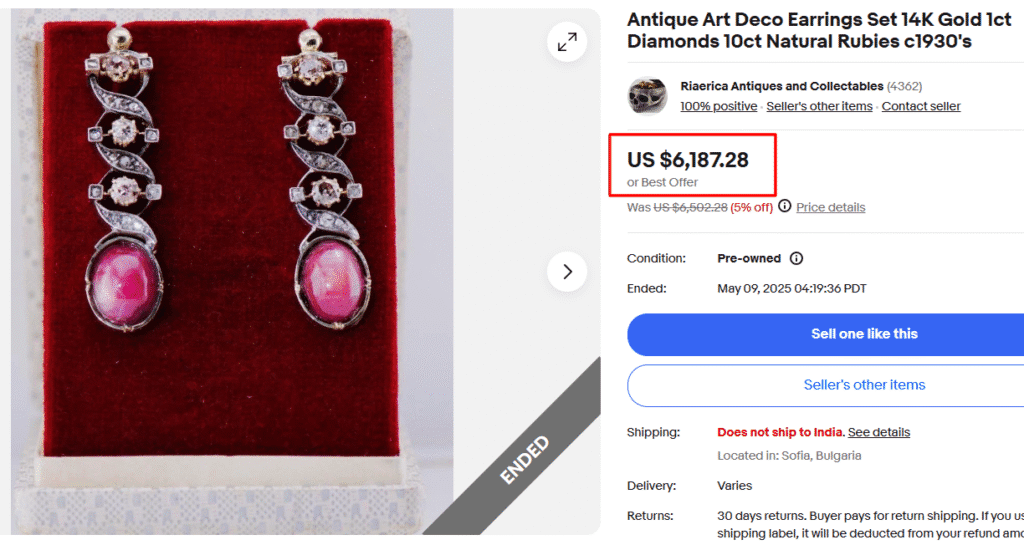
- Brand: Unbranded
- Materials: 14K Gold, Diamond, Natural Rubies
These vintage earrings feature one of Art Deco’s boldest and most dramatic combinations – 1 carat of diamonds paired with 10 carats of natural rubies, all set in 14K white gold! Each piece shows a symmetric spiral design, typical of the era’s style!
Since natural rubies of high quality are getting harder to find, such pieces can easily fetch $4,000-$8,000+ from collectors.
9. Trifari Starburst Alfred Philippe Deco Necklace Earrings Set
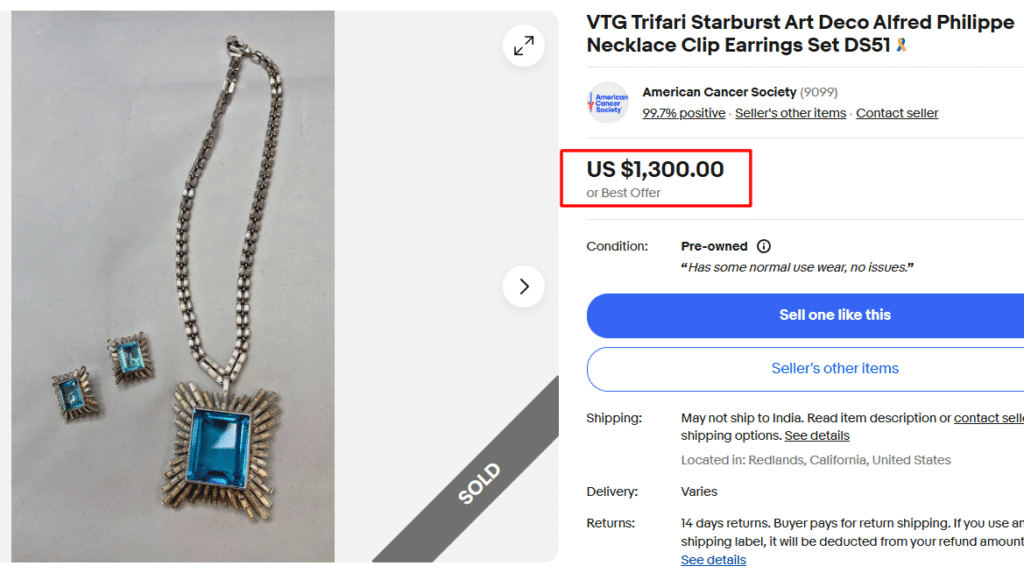
- Brand: Brown Trifari
- Materials: Blue Stone, Metal
This unique necklace and earring set was designed by Alfred Philippe, who’s basically the king of costume jewelry design. The symmetric starburst design with those gorgeous blue stones reflects the geometric boldness of the Art Deco era perfectly.
Sold for $1,300, this piece shows how Trifari pieces from Philippe’s era (1930-1968) are seriously collectible now, especially complete sets!
10. Tiffany & Co. Diamond Platinum Black Enamel Deco Brooch
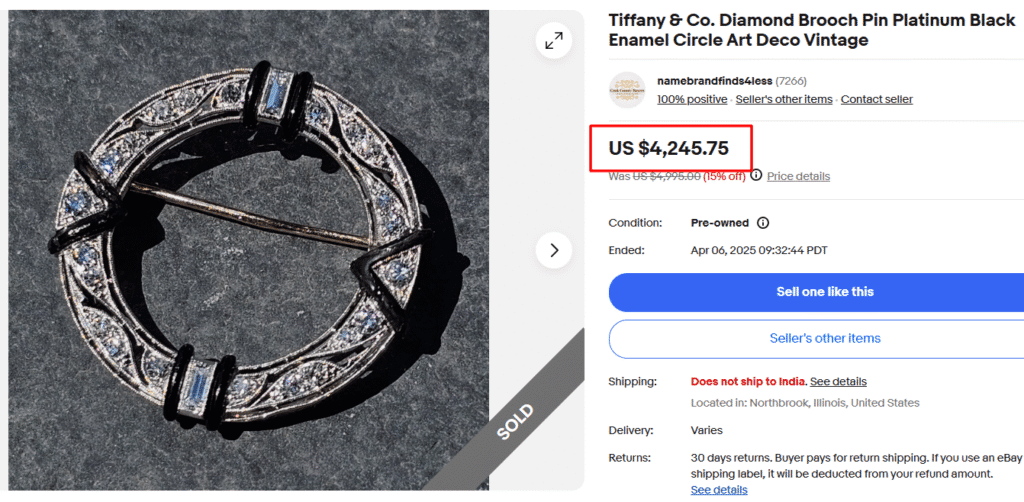
- Brand: Tiffany & Co.
- Materials: Enamel, Diamond, Platinum
Now, “Tiffany & Co.” is in itself a name that grabs eyeballs. And this piece is a combination of this huge name and “Art Deco,” meaning royal jewelry. What you’re looking at is a platinum circle brooch with black enamel decoration and diamonds all around!
The geometric design and the contrasting combination of black enamel and diamonds are some of the defining features of Art Deco pieces! The price tag of $4,250 is well justified for such high-end Tiffany & Co. Deco pieces.
11. Carved Floral Jade Diamond Yellow Gold Bracelet
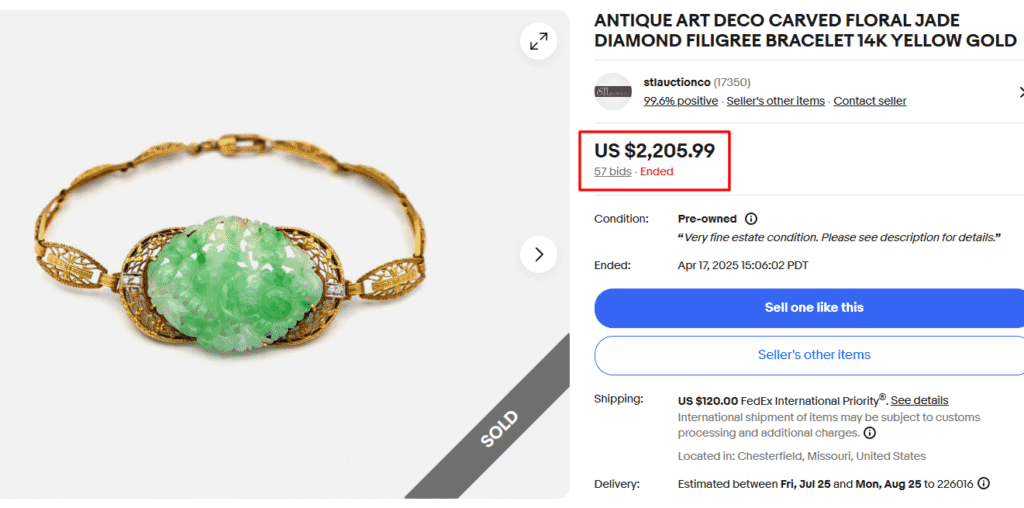
- Brand: Unbranded
- Materials: 14K Yellow Gold, Natural Jade
This rare vintage bracelet shows how Art Deco designers loved using vibrant stones! You’ll see unmatched intricate filigree work paired with hand-carved floral jade – a rare combination that makes this piece worth $900-$4,000!
Jade was incredibly popular during the 1920s-30s! Finding an Art Deco with a well-preserved jade with such detailed carving is quite rare!
12. Art Deco Yellow Gold Lava Cameo & Pearl Pin/Pendant
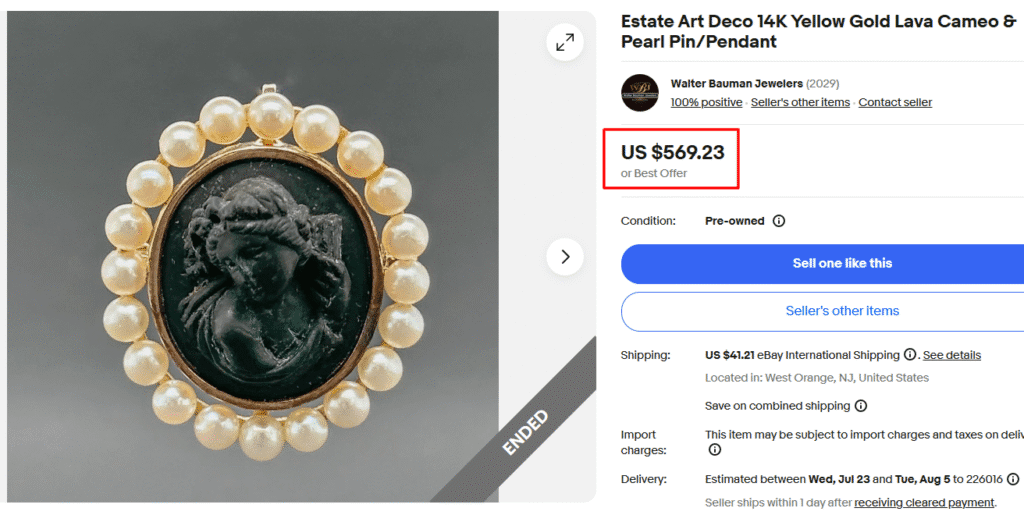
- Brand: Unbranded
- Materials: 14K Yellow Gold, Lava Stone, Pearl
This is a transitional dual-purpose Art Deco pin/pendant featuring a hand-carved lava cameo surrounded by a halo of 20 cultured pearls! The symmetry and geometry you’re seeing in this piece is a classic Art Deco style!
Dating to around 1925, the pin’s got that Linz, Austria, hallmark that verifies its authenticity. While this example sold for a reasonable price of almost $570, such convertible pieces with precious stones can fetch $800-$2,000+!
13. Vintage Deco 14k Yellow Gold Filigree Brooch Pendant
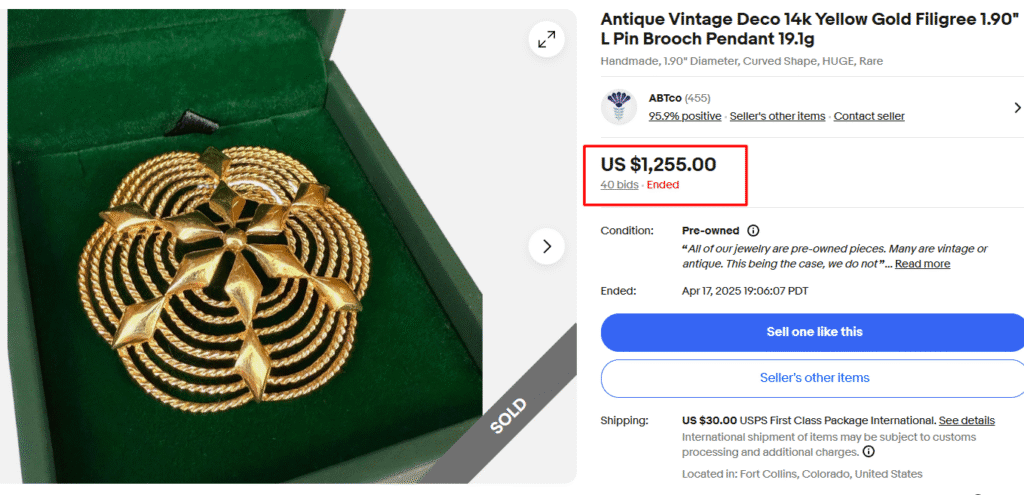
- Brand: Unbranded
- Materials: 14K Yellow Gold
Vintage Filigree goldwork is always collectible! That’s what this substantial golden deco brooch shows off! The curved, almost sculptural design with intricate rings and diamond-shaped arms rising from the center is typical of Art Deco art!
Even without any precious stones or enamel, or lacquer, this piece sold for $1,250 on eBay, showing how collectors love these pieces purely for their antique artistry!
14. ‘Pools of Light’ Rock Crystal Beaded Deco Necklace
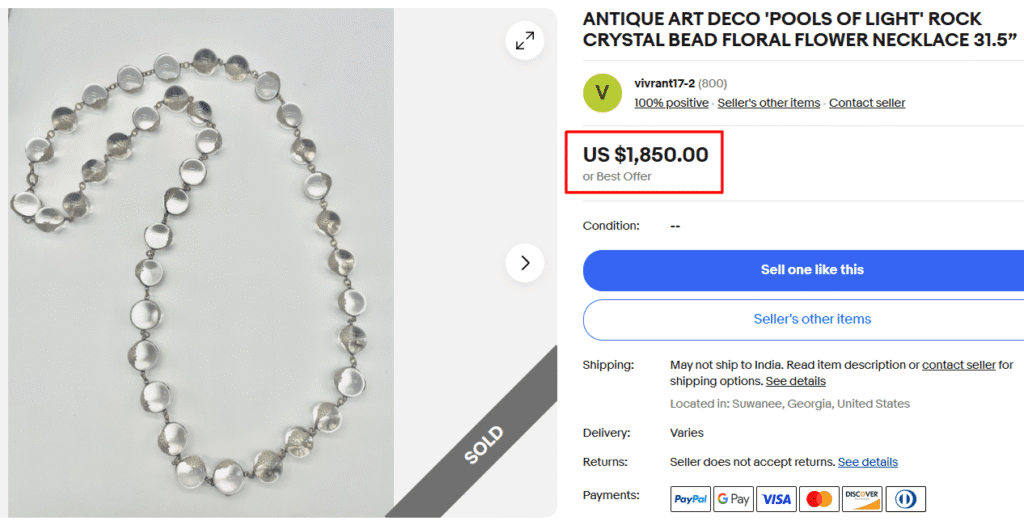
- Brand: Unbranded
- Materials: Rock Crystals
“Pools of Light” jewelry was incredibly popular during the 1920s. It generally features undrilled rock crystal spheres, which people believed captured energy and brought good luck.
The floral motifs show how Art Deco could be both geometric and nature-inspired (still symmetric). The 31.5″ length of this necklace is perfect for that flapper-era styling.
15. Yellow Gold Filigree Aquamarine Art Deco Hat Pin
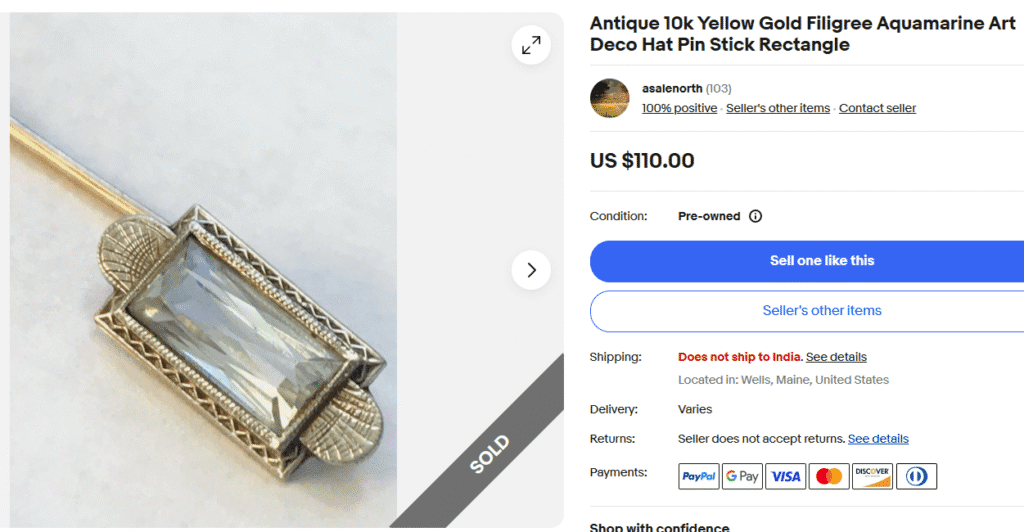
- Brand: Unbranded
- Materials: 10K Yellow Gold, Blue Aquamarine Stone
This is a rare vintage Art Deco hat pin featuring a rectangular aquamarine hat pin! It combines the era’s signature filigree work with that cool blue stone that was quite popular in the 1920s.
Now, this piece realized a quite smaller price compared to other members in this list, and that’s because of the 10k gold construction; 14K or 18K, and it would fetch thousands!
Note: This article is intended for informational, educational, and entertainment purposes only. Some images are illustrative and may not represent actual brands, products, or related entities. All trademarks, product names, brand logos, packaging, and other intellectual property referenced remain the exclusive property of their respective owners. Any brand mentions or references are provided solely for descriptive and educational context and do not imply any formal or commercial association.

